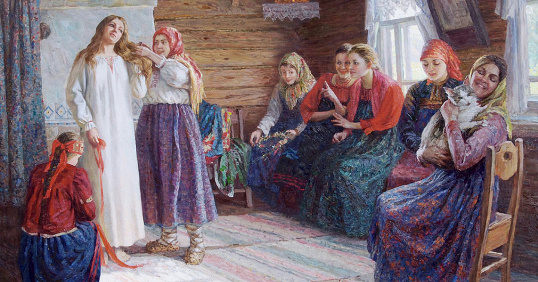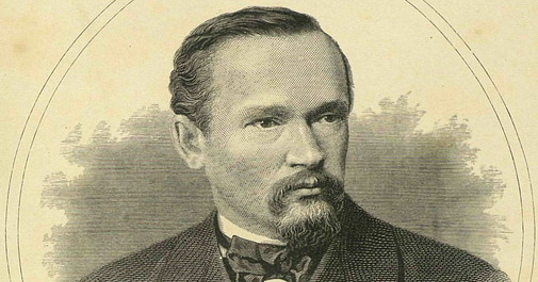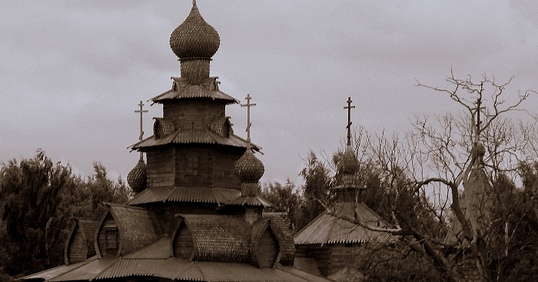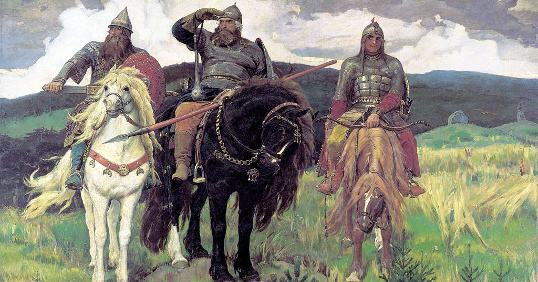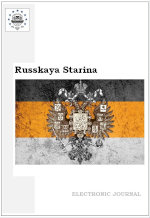1 June 25, 2025
On the 80th Anniversary of Victory in the Great Patriotic War
1. Tlegen S. Sadykov
The Contribution of Kazakhstan to the Great Victory
Russkaya Starina. 2025. 16(1): 4-10.
Number of views: 45 Download in PDF
2. Danil D. SugakRusskaya Starina. 2025. 16(1): 4-10.
Abstract:
This article examines the contribution of the Republic of Kazakhstan to the victory in the Great Patriotic War of 1941–1945. The study highlights the main areas of Kazakhstan’s involvement in combat operations, the role of national military units, and the individual feats of soldiers who were awarded high state honors. Special attention is given to the role of the home front, including the relocation of industrial enterprises and cultural institutions to Kazakhstan’s territory. The article discusses the war’s demographic impact on the republic and addresses controversial aspects of historical memory, such as the fate of Kazakh prisoners of war and members of the Turkestan Legion. The author emphasizes that Kazakhstan’s contribution extended far beyond military operations and included crucial logistical, industrial, and ideological efforts that helped shape national identity. The paper argues that the memory of the war has become a central component of Kazakhstan’s historical narrative and patriotic education. The analysis is based on archival sources, official statistics, war memoirs, and contemporary academic research, reflecting the multifaceted role Kazakhstan played in securing victory.
This article examines the contribution of the Republic of Kazakhstan to the victory in the Great Patriotic War of 1941–1945. The study highlights the main areas of Kazakhstan’s involvement in combat operations, the role of national military units, and the individual feats of soldiers who were awarded high state honors. Special attention is given to the role of the home front, including the relocation of industrial enterprises and cultural institutions to Kazakhstan’s territory. The article discusses the war’s demographic impact on the republic and addresses controversial aspects of historical memory, such as the fate of Kazakh prisoners of war and members of the Turkestan Legion. The author emphasizes that Kazakhstan’s contribution extended far beyond military operations and included crucial logistical, industrial, and ideological efforts that helped shape national identity. The paper argues that the memory of the war has become a central component of Kazakhstan’s historical narrative and patriotic education. The analysis is based on archival sources, official statistics, war memoirs, and contemporary academic research, reflecting the multifaceted role Kazakhstan played in securing victory.
Number of views: 45 Download in PDF
Representation of the Soviet-Finnish War of 1939–1940 in the Russian Information Space
Russkaya Starina. 2025. 16(1): 11-18.
Number of views: 28 Download in PDF
3. Alexander A. OsinniyRusskaya Starina. 2025. 16(1): 11-18.
Abstract:
In this article, we explore the representation of the Soviet-Finnish war of 1939–1940 in the Russian information space. We analyze the evolution of historiographical approaches to conflict, from early Soviet apologetics through a radical revision of the 1990s to a modern synthetic stage critically integrating Russian and Finnish studies. At the same time, special attention is paid to non-academic forms of representation: the role of memoir literature, mass media, literary texts (especially popular genres like combat fiction), cinematography, memorial practices and Internet content (including YouTube), which significantly influence the mass perception of the “Winter War”. We come to the conclusion that the image of war is fragmented and ideologically dependent in the non-academic sphere, its marginalization in the national narrative against the background of the dominance of the theme of the Great Patriotic War, the regionalization of memory in border areas and the tendency towards humanization, which underlines the incompleteness of integrating this event into the Russian mental landscape.
In this article, we explore the representation of the Soviet-Finnish war of 1939–1940 in the Russian information space. We analyze the evolution of historiographical approaches to conflict, from early Soviet apologetics through a radical revision of the 1990s to a modern synthetic stage critically integrating Russian and Finnish studies. At the same time, special attention is paid to non-academic forms of representation: the role of memoir literature, mass media, literary texts (especially popular genres like combat fiction), cinematography, memorial practices and Internet content (including YouTube), which significantly influence the mass perception of the “Winter War”. We come to the conclusion that the image of war is fragmented and ideologically dependent in the non-academic sphere, its marginalization in the national narrative against the background of the dominance of the theme of the Great Patriotic War, the regionalization of memory in border areas and the tendency towards humanization, which underlines the incompleteness of integrating this event into the Russian mental landscape.
Number of views: 28 Download in PDF
The War of Stories. The Role and Significance of the Battle of Kursk in National and Foreign Historiography
Russkaya Starina. 2025. 16(1): 19-28.
Number of views: 30 Download in PDF
Russkaya Starina. 2025. 16(1): 19-28.
Abstract:
The Battle of Kursk has always caused disputes among historians. Since the end of the war, a huge number of research have been published among Russian and foreign authors. This article analyzes the existing assessments of the Battle of Kursk, and similarities and differences are identified. Particular attention is paid to the problem of distortion and falsification of the events of the battle of Western experts, and the history of the origin of these trends is considered, the works of Soviet and Russian historians are analyzed. Domestic historiography traditionally emphasizes the important role of the Battle of Kursk, in the history of the Great Patriotic War and the Second World War as a whole. The authors focus on the heroism of soldiers and commanders, the superiority of Soviet military science, the most important results and the consequences of the battle. In foreign literature, one can often find information about overstated Soviet losses, doubts about the effectiveness of decisions of the top leadership of the USSR and the Soviet accusations of unjustified victims among personnel. In addition, Western historians, referring to the memoirs of German generals, believe that the landing of allied troops in Sicily played the most important role in the victory of the Red Army. Among the Western authors there are also those who objectively evaluate the events of the Battle of Kursk, but this did not affect the general trend aimed at distorting the events of the war.
The Battle of Kursk has always caused disputes among historians. Since the end of the war, a huge number of research have been published among Russian and foreign authors. This article analyzes the existing assessments of the Battle of Kursk, and similarities and differences are identified. Particular attention is paid to the problem of distortion and falsification of the events of the battle of Western experts, and the history of the origin of these trends is considered, the works of Soviet and Russian historians are analyzed. Domestic historiography traditionally emphasizes the important role of the Battle of Kursk, in the history of the Great Patriotic War and the Second World War as a whole. The authors focus on the heroism of soldiers and commanders, the superiority of Soviet military science, the most important results and the consequences of the battle. In foreign literature, one can often find information about overstated Soviet losses, doubts about the effectiveness of decisions of the top leadership of the USSR and the Soviet accusations of unjustified victims among personnel. In addition, Western historians, referring to the memoirs of German generals, believe that the landing of allied troops in Sicily played the most important role in the victory of the Red Army. Among the Western authors there are also those who objectively evaluate the events of the Battle of Kursk, but this did not affect the general trend aimed at distorting the events of the war.
Number of views: 30 Download in PDF
Articles and Statements
4. Evgeny F. Krinko
The Images of Soviet Past in the Contemporary Georgian Historiography
Russkaya Starina. 2025. 16(1): 29-44.
Number of views: 28 Download in PDF
5. Yerlan K. Jiyenaliev, Zlikha O. Ibadullayeva, Zhazira O. Khassenova, Gulden B. ImangalievaRusskaya Starina. 2025. 16(1): 29-44.
Abstract:
This article was devoted to understanding Soviet history in contemporary Georgian historiography. The main attention is paid to: general assessment of the Soviet period in the history of Georgia; the establishment of Soviet power; relation to I.V. Stalin; political repressions. The main historiographical sources are generalizing and special jobs of Georgian historians. The author relied on the principle of historicism and a systematic approach, used methods of logical and historiographic analysis, comparative historical and problem-chronological methods. Contemporary Georgia is considered to be the successor of the Georgian Democratic Republic (1918–1921). On the contrary, the history of the Georgian SSR and the Georgian SSR (1921–1991) is not recognized as a full-fledged stage in the development of Georgian national statehood. The establishment of Soviet power in 1921 is assessed by most Georgian historians as the "occupation" of Georgia by Soviet Russia. The Soviet period of history is subject to a radical reassessment, although the attitude personally to Stalin as the leader of the Soviet state retains a certain specificity. The considerable attention is paid to political repressions, and the experience of Soviet modernization is actually devalued. The Soviet past in Georgia is not consigned to oblivion, but serves as the basis for the formation of national identity based on the victimization of the past.
This article was devoted to understanding Soviet history in contemporary Georgian historiography. The main attention is paid to: general assessment of the Soviet period in the history of Georgia; the establishment of Soviet power; relation to I.V. Stalin; political repressions. The main historiographical sources are generalizing and special jobs of Georgian historians. The author relied on the principle of historicism and a systematic approach, used methods of logical and historiographic analysis, comparative historical and problem-chronological methods. Contemporary Georgia is considered to be the successor of the Georgian Democratic Republic (1918–1921). On the contrary, the history of the Georgian SSR and the Georgian SSR (1921–1991) is not recognized as a full-fledged stage in the development of Georgian national statehood. The establishment of Soviet power in 1921 is assessed by most Georgian historians as the "occupation" of Georgia by Soviet Russia. The Soviet period of history is subject to a radical reassessment, although the attitude personally to Stalin as the leader of the Soviet state retains a certain specificity. The considerable attention is paid to political repressions, and the experience of Soviet modernization is actually devalued. The Soviet past in Georgia is not consigned to oblivion, but serves as the basis for the formation of national identity based on the victimization of the past.
Number of views: 28 Download in PDF
Formation of the Old-Faith Population of Rudny Altai in the XVII–XIX centuries
Russkaya Starina. 2025. 16(1): 45-57.
Number of views: 55 Download in PDF
6. Sergei A. KropachevRusskaya Starina. 2025. 16(1): 45-57.
Abstract:
The article examines the appearance, economic and socio-cultural adaptation of the Old Believers in the territory of the Rudny Altai in the XVII–XIX centuries. Russian Russians Based on the works of researchers and archival documents, an attempt has been made to study and evaluate Old Believers as a complex religious, ideological and cultural phenomenon of Russian reality, the worldview of millions of Russian people, which determined all aspects of the life of its supporters and became in the XVII–XIX centuries a fact and even a factor in the history of not only Russia, but also Kazakhstan. Being in the most difficult economic and legal conditions, despite all the difficulties experienced, the Old Believer communities of the Rudny Altai led their intensive lives and, as best they could, survived in a foreign environment. The relations of the Old Believers are shown not only with the authorities and the Orthodox population, but also with the nomadic Kazakhs. The need for an exhaustively complete reproduction of tradition in a constantly changing environment led to the paradoxical position of the individual, which required maximum “mobility” to adapt to the new in order to maintain “immobility”, i. e. the traditional old one. The authors concluded that one of the most important reasons for preserving the foundations, traditions, and way of life is the comprehensive protection of the institution of the family among the Old Believers, who played a primary role in the life of the Old Believer society.
The article examines the appearance, economic and socio-cultural adaptation of the Old Believers in the territory of the Rudny Altai in the XVII–XIX centuries. Russian Russians Based on the works of researchers and archival documents, an attempt has been made to study and evaluate Old Believers as a complex religious, ideological and cultural phenomenon of Russian reality, the worldview of millions of Russian people, which determined all aspects of the life of its supporters and became in the XVII–XIX centuries a fact and even a factor in the history of not only Russia, but also Kazakhstan. Being in the most difficult economic and legal conditions, despite all the difficulties experienced, the Old Believer communities of the Rudny Altai led their intensive lives and, as best they could, survived in a foreign environment. The relations of the Old Believers are shown not only with the authorities and the Orthodox population, but also with the nomadic Kazakhs. The need for an exhaustively complete reproduction of tradition in a constantly changing environment led to the paradoxical position of the individual, which required maximum “mobility” to adapt to the new in order to maintain “immobility”, i. e. the traditional old one. The authors concluded that one of the most important reasons for preserving the foundations, traditions, and way of life is the comprehensive protection of the institution of the family among the Old Believers, who played a primary role in the life of the Old Believer society.
Number of views: 55 Download in PDF
Population Dynamics in Multinational Russia in the 1920s
Russkaya Starina. 2025. 16(1): 58-69.
Number of views: 53 Download in PDF
7. Semyon N. Gonta, Manushak N. PlyakichRusskaya Starina. 2025. 16(1): 58-69.
Abstract:
The article analyzes the results of the crisis decade (1914–1922) in Russian history. During these years, the country experienced the First World War and the Civil War, revolutions, intervention, political terror, epidemics, and the famine of 1921–1922, as well as changes in its borders. These events had a significant impact on the population, gender distribution, and age groups. The author explores the positive trends in the demographic development of the country and its peoples that emerged after the end of the Civil War, the demobilization of the army, and the introduction of the New Economic Policy. In the 1920s, pandemics and epidemics were defeated, mortality rates decreased, and birth rates and life expectancy increased. The article explores the demographic development of Russia's “major” ethnic groups and their significance for the sustainable development of a multi-ethnic country. The balance of population reproduction depended on exogenous and endogenous factors. Exogenous factors, such as famine, epidemics, deportations, terrorism, changes in borders, and mass migrations, had a negative impact on the growth rate of ethnic groups. Endogenous processes, on the other hand, had a positive effect on population dynamics. Internal processes include the established type of population reproduction and the traditional way of life of the peoples.
The article analyzes the results of the crisis decade (1914–1922) in Russian history. During these years, the country experienced the First World War and the Civil War, revolutions, intervention, political terror, epidemics, and the famine of 1921–1922, as well as changes in its borders. These events had a significant impact on the population, gender distribution, and age groups. The author explores the positive trends in the demographic development of the country and its peoples that emerged after the end of the Civil War, the demobilization of the army, and the introduction of the New Economic Policy. In the 1920s, pandemics and epidemics were defeated, mortality rates decreased, and birth rates and life expectancy increased. The article explores the demographic development of Russia's “major” ethnic groups and their significance for the sustainable development of a multi-ethnic country. The balance of population reproduction depended on exogenous and endogenous factors. Exogenous factors, such as famine, epidemics, deportations, terrorism, changes in borders, and mass migrations, had a negative impact on the growth rate of ethnic groups. Endogenous processes, on the other hand, had a positive effect on population dynamics. Internal processes include the established type of population reproduction and the traditional way of life of the peoples.
Number of views: 53 Download in PDF
From the History of One Operation of the Sochi District Police to Combat Illegal Alcohol Production in 1923
Russkaya Starina. 2025. 16(1): 70-75.
Number of views: 30 Download in PDF
8. Nicholas W. Mitiukov, Yury L. KimRusskaya Starina. 2025. 16(1): 70-75.
Abstract:
This article is devoted to the study of the topic of the fight against arak and its sale in the Sochi in 1923. The materials of the Sochi City Archives are used as the basis for the research in this work. The research methodology is represented by both general scientific (analysis, synthesis, induction, deduction, classification method) and special historical research methods (historicalgenetic and narrative). The authors present the activities carried out and the results of a two-week fight against illegal alcohol in Sochi (from January 1 to January 15, 1923). It is noted that based on the results of the operation, a number of protocols were drawn up, including for repeat offenders, three of whom received real sentences. Several restaurants were also closed, and a number of fines were imposed totaling about 12 thousand rubles. It is separately noted that the cooking of illegal alcohol took place in rural areas, from where it was later delivered to the city, while the fight against illegal alcohol cooking was complicated by a number of factors.
This article is devoted to the study of the topic of the fight against arak and its sale in the Sochi in 1923. The materials of the Sochi City Archives are used as the basis for the research in this work. The research methodology is represented by both general scientific (analysis, synthesis, induction, deduction, classification method) and special historical research methods (historicalgenetic and narrative). The authors present the activities carried out and the results of a two-week fight against illegal alcohol in Sochi (from January 1 to January 15, 1923). It is noted that based on the results of the operation, a number of protocols were drawn up, including for repeat offenders, three of whom received real sentences. Several restaurants were also closed, and a number of fines were imposed totaling about 12 thousand rubles. It is separately noted that the cooking of illegal alcohol took place in rural areas, from where it was later delivered to the city, while the fight against illegal alcohol cooking was complicated by a number of factors.
Number of views: 30 Download in PDF
System Analysis in the Reconstruction of Rotaprint Images of Typewritten Text: Using the Example of Orders for the Distribution of the Fleet of the Kamlesosplav Trust, 1939–1948
Russkaya Starina. 2025. 16(1): 76-97.
Number of views: 34 Download in PDF
9. Russkaya Starina. 2025. 16(1): 76-97.
Abstract:
In rotaprint images, the greatest problems are related to the identification of numbers. Unclearly printed alphabetic characters are usually identified by meaning, which is not the case for numbers. Based on the example of the analysis of rotaprinted bulletins of the “Kamlesosplav” trust from the period 1939–1948, the following identification technique is proposed. At the first stage, the numbers available in the document are grouped: firstly, numbers are identified whose reading there is no doubt about, secondly, in the reading of which there are several alternative options, and thirdly, unreadable numbers. At the second stage, the presence of any of the alternative numbers later in the document is determined. If it is available, it is crossed out from the list of alternatives. Finally, at the third stage, an analysis of earlier or later documents is carried out, due to the fact that individual boats worked in a particular farm for several years. Based on this methodology, the identification of boat numbers in orders for the distribution of the fleet of the period 1939–1948 was carried out, the resulting numbers were summarized in a table. Analysis of these data made it possible to assert that despite the fairly serious mobilization of vessels from timber rafting farms in other regions (primarily northern rivers), the mobilization of the vessel personnel of the “Kamlesosplav” trust was carried out to an extremely limited extent. Most likely, ships from the Astrakhan, Stalingrad and Saratov agencies were involved in combat missions, as they found themselves directly in the area of combat operations on the Lower Volga. On the other hand, throughout the war years there has been an increase in the number of vessels in the trust's fleet: compared to 1939 in the middle of the war, approximately one and a half times, and during the post-war restoration of the national economy, more than twice. In particular, judging by the reference book by S.S. Berezhnoi, at least five decommissioned and disarmed minesweepers were transferred to the trust. Thus, the reconstructed data allows us to establish that “Kamlesosplav” during the Great Patriotic War solved the important strategic task of providing forests and forest materials to the farms of the lower Volga, including the needs of the front. Because of this, the transfer of trust vessels to other farms was carried out in extremely limited quantities. And vice versa, “Kamlesosplav” itself accepted former mobilized ships from other farms.
In rotaprint images, the greatest problems are related to the identification of numbers. Unclearly printed alphabetic characters are usually identified by meaning, which is not the case for numbers. Based on the example of the analysis of rotaprinted bulletins of the “Kamlesosplav” trust from the period 1939–1948, the following identification technique is proposed. At the first stage, the numbers available in the document are grouped: firstly, numbers are identified whose reading there is no doubt about, secondly, in the reading of which there are several alternative options, and thirdly, unreadable numbers. At the second stage, the presence of any of the alternative numbers later in the document is determined. If it is available, it is crossed out from the list of alternatives. Finally, at the third stage, an analysis of earlier or later documents is carried out, due to the fact that individual boats worked in a particular farm for several years. Based on this methodology, the identification of boat numbers in orders for the distribution of the fleet of the period 1939–1948 was carried out, the resulting numbers were summarized in a table. Analysis of these data made it possible to assert that despite the fairly serious mobilization of vessels from timber rafting farms in other regions (primarily northern rivers), the mobilization of the vessel personnel of the “Kamlesosplav” trust was carried out to an extremely limited extent. Most likely, ships from the Astrakhan, Stalingrad and Saratov agencies were involved in combat missions, as they found themselves directly in the area of combat operations on the Lower Volga. On the other hand, throughout the war years there has been an increase in the number of vessels in the trust's fleet: compared to 1939 in the middle of the war, approximately one and a half times, and during the post-war restoration of the national economy, more than twice. In particular, judging by the reference book by S.S. Berezhnoi, at least five decommissioned and disarmed minesweepers were transferred to the trust. Thus, the reconstructed data allows us to establish that “Kamlesosplav” during the Great Patriotic War solved the important strategic task of providing forests and forest materials to the farms of the lower Volga, including the needs of the front. Because of this, the transfer of trust vessels to other farms was carried out in extremely limited quantities. And vice versa, “Kamlesosplav” itself accepted former mobilized ships from other farms.
Number of views: 34 Download in PDF



